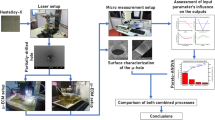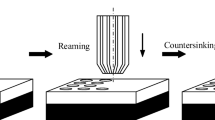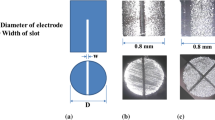Abstract
Despite considerable research effort being concentrated on improving hole quality, minimisation of burrs still remains a key challenge in mechanical microdrilling of ductile materials. Recently, a sequential laser-mechanical microdrilling technique, which was developed by the authors, has proved effective in improving tool life and reducing burr size. The improvement in burr size was achieved by means of laser predrilling a pilot hole before utilising a twist drill to finish the hole. This paper presents further development of the sequential laser-mechanical microdrilling process based on negative-tapered laser-drilled pilot holes. In the sequential laser-mechanical microdrilling process, although a large predrilled hole reduces the burr size, it has a negative effect on roundness and cylindricity of the hole. The results of further studies highlight that a smaller entry hole size supports the drill and suppresses tool wander which, in turn, improves hole cylindricity. Furthermore, a larger exit hole size significantly reduces burr size. Compared to pure mechanical drilling without any pilot hole, the reduction in burr size for the mechanical microdrilling of near zero tapper and negatively tapered laser-predrilled holes was observed to be 2.5 and 6 times, respectively. Moreover, the mechanical finishing of these holes does not compromise tool life and/or surface integrity. Thus, the use of a negative taper laser-predrilled hole presents a significant improvement in burr control in microdrilling of nickel-based super alloys in addition to providing a step change increase in tool life.
Similar content being viewed by others
References
Aurich JC, Dornfeld D, Arrazola PJ, Franke V, Leitz L, Min S (2009) Burrs—analysis, control and removal. CIRP Ann Manuf Technol 58(2):519–542
Ko S-L, Lee J-K (2001) Analysis of burr formation in drilling with a new-concept drill. J Mater Process Technol 113:392–398
Chang SSF, Bone GM (2005) Burr size reduction in drilling by ultrasonic assistance. Robotics Comput-Integr Manuf 21(4–5):442–450
Byrne G, Dornfeld D, Denkena B (2003) Advancing cutting technology. CIRP Ann Manuf Technol 52(2):483–507
Sung-Lim K, Dornfeld DA (1991) A study on burr formation mechanism. Transac ASME J Eng Mater Technol 113(1):75–87
Chae J, Park SS, Freiheit T (2006) Investigation of micro-cutting operations. Int J Mach Tool Manuf 46(3–4):313–332
Lin TR, Shyu RF (2000) Improvement of tool life and exit burr using variable feeds when drilling stainless steel with coated drills. Int J Adv Manuf Technol 16(5):308–313
Dornfeld D, Min S, Takeuchi Y (2006) Recent advances in mechanical micromachining. CIRP Ann Manuf Technol 55(2):745–768
Kim J, Dornfeld DA (2001) Cost estimation of drilling operations by a drilling burr control chart and Bayesian statistics. J Manuf Syst 20(2):89–97
Ramu C, Mehta NK, Kumar P, Shankara Murthy AG (2010) Experimental investigations to optimise step drill geometry for burr minimisation in drilling using regression model. Int J Manuf Technol Manag 21(1–2):122–134
Aurich JC, Dornfeld D, Melkote SN, Newton TR, Hellstern C, Morehouse JB, Turner S (2010) Interfacial Burr Formation in Drilling of Stacked Aerospace Materials. In: Burrs - Analysis, Control and Removal. Springer Berlin Heidelberg, pp 89–98. doi:10.1007/978-3-642-00568-8_10
Okasha MM, Mativenga PT, Li L (2011) Sequential laser mechanical microdrilling of Inconel 718 alloy. J Manuf Sci Eng 133(1):011008–011008
Kim J, Min S, Dornfeld DA (2001) Optimization and control of drilling burr formation of AISI 304 L and AISI 4118 based on drilling burr control charts. Int J Mach Tool Manuf 41(7):923–936
Ramachandran N, Pande SS, Ramakrishnan N (1994) Role of deburring in manufacturing: a state-of-the-art survey. J Mater Process Technol 44(1–2):1–13
Pande SS, Relekar HP (1986) Investigations on reducing burr formation in drilling. Int J Mach Tool Des & Res 26(3):339–348
Hashimura M, Hassamontr J, Dornfeld DA (1999) Effect of in-plane exit angle and rake angles on burr height and thickness in face milling operation. J Manuf Sci Eng, Transac ASME 121(1):13–19
Gillespie LK (1976) Effects of drilling variables on burr properties, technical report. Bendix, United States
Gaitonde VN, Karnik SR, Achyutha BT, Siddeswarappa B (2008) Taguchi optimization in drilling of AISI 316L stainless steel to minimize burr size using multi-performance objective based on membership function. J Mater Process Technol 202(1–3):374–379
Jinsoo K, Dornfeld DA (2002) Development of an analytical model for drilling burr formation in ductile materials. Transac ASME J Eng Mater Technol 124(2):192–198
Stein JM, Dornfeld DA (1997) Burr formation in drilling miniature holes. CIRP Ann Manuf Technol 46(1):63–66
Kiha L, Dornfeld DA (2005) Micro-burr formation and minimization through process control. Precis Eng 29(2):246–252
Ko SL, Chang JE (2003) Development of drill geometry for burr minimization in drilling. CIRP Ann Manuf Technol 52(1):45–48
Sung-Lim K, Jae-Eun C, Gyun-Eui Y (2003) Burr minimizing scheme in drilling. J Mater Process Technol 140(1–3):237–242
Xia RS, Mahdavian SM (2005) Experimental studies of step drills and establishment of empirical equations for the drilling process. Int J Mach Tool Manuf 45(2):235–240
Yunming Z, Guicheng W, Pingkuan Z, Lijie M, Chunyan Z A study on burr formation and controlling technology in precision or ultra-precision drilling. In: Proceedings of the International Conference on Integration and Commercialization of Micro and Nanosystems, New York, NY 10016–5990, United States, 2007. Proceedings of the International Conference on Integration and Commercialization of Micro and Nanosystems 2007. American Society of Mechanical Engineers, pp 1509–1512
D-y Z, X-j F, L-j W, D-c C (1994) Study on the drill skidding motion in ultrasonic vibration microdrilling. Int J Mach Tool Manuf 34(6):847–857
Liao YS, Chen YC, Lin HM (2007) Feasibility study of the ultrasonic vibration assisted drilling of Inconel superalloy. Int J Mach Tool Manuf 47(12–13):1988–1996
Ko SL, Dornfeld DA (1996) Burr formation and fracture in oblique cutting. J Mater Process Technol 62(1–3):24–36
Okasha MM, Mativenga PT, Driver N, Li L (2010) Sequential laser and mechanical micro-drilling of Ni superalloy for aerospace application. CIRP Ann Manuf Technol 59(1):199–202
Abdel Mohsen Mahdy M (2001) Economic drilling conditions for a given deburring radius. J Mater Process Technol 110(2):197–205
Leopold J, Schmidt G Methods of burr measurement and burr detection. In, 2004. VDI Berichte. VDI, pp 223-229 + 794
Benati F, Butler C, Gatti S, Sacerdotti F, Yang Q Robot-based burr measurement system for the automotive industry. In: Conference Record - IEEE Instrumentation and Measurement Technology Conference, Venice, Italy, 1999. IEEE, pp 1740–1744
Chen YC, Liao YS (2003) Study on wear mechanisms in drilling of Inconel 718 superalloy. J Mater Process Technol 140(1–3):269–273
Heinemann R, Hinduja S, Barrow G, Petuelli G (2006) The performance of small diameter twist drills in deep-hole drilling. Transac ASME J Manuf Sci Eng 128(4):884–892
Jindal PC, Santhanam AT, Schleinkofer U, Shuster AF (1999) Performance of PVD TiN, TiCN, and TiAlN coated cemented carbide tools in turning. Int J Refract Metals Hard Mater 17(1):163–170
Garcia-Diaz A, Phillips DT (1995) Principles of experimental design and analysis. Chapman & Hall, London
Peace GS (1993) Taguchi methods: a hands-on approach. Addison-Wesley, Reading, MA
Lee SJ, Eman KF, Wu SM (1987) Analysis of the drill wandering motion. J Eng Ind 109(4):297–305
Fujii H, Marui E, Ema S (1986) Whirling vibration in drilling. Part 1: cause of vibration and role of chisel edge. J Eng Ind 108(3):157–162
Fujii H, Marui E, Ema S (1986) Whirling vibration in drilling—part 2: influence of drill geometries, particularly of the drill flank, on the initiation of vibration. J Eng Ind 108:163–168
Wijeyewickrema AC, Keer LM, Ehmann KF (1995) Drill wandering motion. Experiment and analysis. Int J Mech Sci 37(5):495–495
Krar SF, Oswald JW (1990) Technology of machine tools, 4th edn. Gregg Division, McGraw-Hill, New York
Zhang PF, Churi NJ, Pei ZJ, Treadwell C (2008) Mechanical drilling processes for titanium alloys: a literature review. Mach Sci Technol 12(4):417–444
Kurt M, Kaynak Y, Bagci E (2008) Evaluation of drilled hole quality in Al 2024 alloy. Int J Adv Manuf Technol 37(11–12):1051–1060
Deng C-S, Chin J-H (2005) Hole roundness in deep-hole drilling as analysed by Taguchi methods. Int J Adv Manuf Technol 25(5–6):420–426
Imran M, Mativenga PT, Kannan S, Novovic D (2008) An experimental investigation of deep-hole microdrilling capability for a nickel-based superalloy. Proc Inst Mech Eng, Part B: J Eng Manuf 222(12):1589–1596
Ross PJ (1996) Taguchi techniques for quality engineering 2nd edn. McGraw-Hill, New York
Chen W-C (1996) Effect of the cross-sectional shape design of a drill body on drill temperature distributions. Int Commun Heat and Mass Transfer 23(3):355–366
Sharman ARC, Amarasinghe A, Ridgway K (2008) Tool life and surface integrity aspects when drilling and hole making in Inconel 718. J Mater Process Technol 200(1–3):424–432
Won MS, Dharan CKH (2002) Chisel edge and pilot hole effects in drilling composite laminates. J Manuf Sci Eng, Transac ASME 124(2):242–247
Strenkowski JS, Hsieh CC, Shih AJ (2004) An analytical finite element technique for predicting thrust force and torque in drilling. Int J Mach Tool Manuf 44(12–13):1413–1421
Olson RW, Swope WC (1992) Laser drilling with focused Gaussian beams. J Appl Phys 72(8):3686–3696
Yilbas BS, Sami M (1996) Study into the effect of beam waist position on hole formation in the laser drilling process. Proc Inst Mech Eng, Part B: J Eng Manuf 210(B3):271–277
Low DKY (2001) Spatter and taper control in laser percussion drilling. PhD, PhD Thesis, UMIST, Manchester, UK
Li L, Low DKY, Ghoreshi M, Crookall JR (2002) Hole taper characterisation and control in laser percussion drilling. CIRP Ann Manuf Technol 51(1):153–156
Imran M, Mativenga P, Gholinia A, Withers P (doi:10.1007/s00170-010-3062-z Key: citeulike:8602669, 2010) Evaluation of surface integrity in micro drilling process for nickel-based superalloy. The Int J of Adv Manuf Technol
Author information
Authors and Affiliations
Corresponding author
Rights and permissions
About this article
Cite this article
Okasha, M.M., Driver, N., Mativenga, P.T. et al. Mechanical microdrilling of negative-tapered laser-predrilled holes: a new approach for burr minimization. Int J Adv Manuf Technol 61, 213–225 (2012). https://doi.org/10.1007/s00170-011-3714-7
Received:
Accepted:
Published:
Issue Date:
DOI: https://doi.org/10.1007/s00170-011-3714-7




